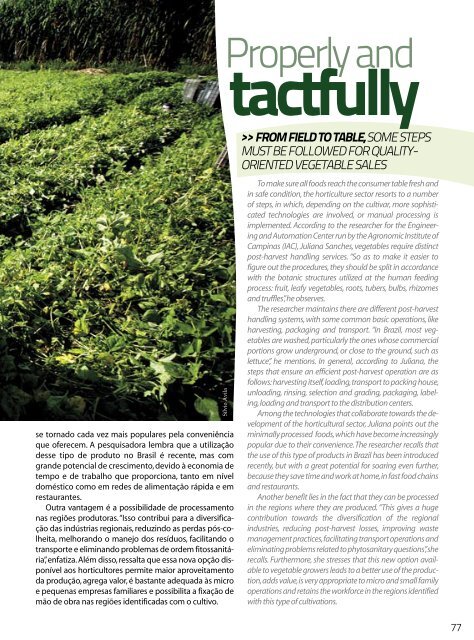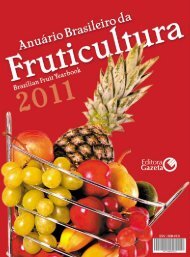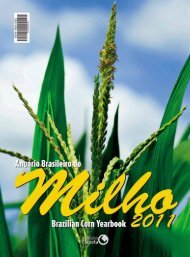tradicionalmenteinovador - Brazil Buyers & Sellers
tradicionalmenteinovador - Brazil Buyers & Sellers
tradicionalmenteinovador - Brazil Buyers & Sellers
You also want an ePaper? Increase the reach of your titles
YUMPU automatically turns print PDFs into web optimized ePapers that Google loves.
se tornado cada vez mais populares pela conveniência<br />
que oferecem. A pesquisadora lembra que a utilização<br />
desse tipo de produto no Brasil é recente, mas com<br />
grande potencial de crescimento, devido à economia de<br />
tempo e de trabalho que proporciona, tanto em nível<br />
doméstico como em redes de alimentação rápida e em<br />
restaurantes.<br />
Outra vantagem é a possibilidade de processamento<br />
nas regiões produtoras. “Isso contribui para a diversificação<br />
das indústrias regionais, reduzindo as perdas pós-colheita,<br />
melhorando o manejo dos resíduos, facilitando o<br />
transporte e eliminando problemas de ordem fitossanitária”,<br />
enfatiza. Além disso, ressalta que essa nova opção disponível<br />
aos horticultores permite maior aproveitamento<br />
da produção, agrega valor, é bastante adequada às micro<br />
e pequenas empresas familiares e possibilita a fixação de<br />
mão de obra nas regiões identificadas com o cultivo.<br />
Sílvio Ávila<br />
Properly and<br />
tactfully<br />
>> From field to table, some steps<br />
must be followed for qualityoriented<br />
vegetable sales<br />
To make sure all foods reach the consumer table fresh and<br />
in safe condition, the horticulture sector resorts to a number<br />
of steps, in which, depending on the cultivar, more sophisticated<br />
technologies are involved, or manual processing is<br />
implemented. According to the researcher for the Engineering<br />
and Automation Center run by the Agronomic Institute of<br />
Campinas (IAC), Juliana Sanches, vegetables require distinct<br />
post-harvest handling services. “So as to make it easier to<br />
figure out the procedures, they should be split in accordance<br />
with the botanic structures utilized at the human feeding<br />
process: fruit, leafy vegetables, roots, tubers, bulbs, rhizomes<br />
and truffles”, he observes.<br />
The researcher maintains there are different post-harvest<br />
handling systems, with some common basic operations, like<br />
harvesting, packaging and transport. “In <strong>Brazil</strong>, most vegetables<br />
are washed, particularly the ones whose commercial<br />
portions grow underground, or close to the ground, such as<br />
lettuce”, he mentions. In general, according to Juliana, the<br />
steps that ensure an efficient post-harvest operation are as<br />
follows: harvesting itself, loading, transport to packing house,<br />
unloading, rinsing, selection and grading, packaging, labeling,<br />
loading and transport to the distribution centers.<br />
Among the technologies that collaborate towards the development<br />
of the horticultural sector, Juliana points out the<br />
minimally processed foods, which have become increasingly<br />
popular due to their convenience. The researcher recalls that<br />
the use of this type of products in <strong>Brazil</strong> has been introduced<br />
recently, but with a great potential for soaring even further,<br />
because they save time and work at home, in fast food chains<br />
and restaurants.<br />
Another benefit lies in the fact that they can be processed<br />
in the regions where they are produced. “This gives a huge<br />
contribution towards the diversification of the regional<br />
industries, reducing post-harvest losses, improving waste<br />
management practices, facilitating transport operations and<br />
eliminating problems related to phytosanitary questions”, she<br />
recalls. Furthermore, she stresses that this new option available<br />
to vegetable growers leads to a better use of the production,<br />
adds value, is very appropriate to micro and small family<br />
operations and retains the workforce in the regions identified<br />
with this type of cultivations.<br />
77





